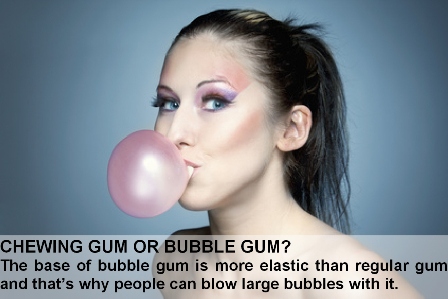CHEWING GUM
Chewing gum is made from gum base. At the beginning, the gum bas was usually the sap from trees. Nowadays the base contains manmade polymers.
To make the gum sweet and chewy, natural or artificial sugars, vegetable oil and flavourings are added. The warmth of a person’s mouth makes the hard piece of gum soft and chewy.
Chewing gum has been around for thousands of years. Stone Age people chewed birch bark tar. Scientists have found prehistoric samples of this tar with human teeth marks in them! Because most of these marks are small, scientists think that it was chewed mainly by children and teenagers.
The Ancient Maya Indians of Mexico chewed chicle, which is the sap of sapodilla tree. Natural chicle was the basis of Chiclets gum, which was invented by American Henry Fleer in 1906. Fleer added a sugar coating to the chicle to make it taste better.
The history of chewing gum in North America began with the Native people, who chewed the sap of spruce trees. Settlers picked up the habit from them. From about 1850 to 1930, several American inventors worked to improve the quality and flavour of the gum. In 1871, Thomas Adams invented a machine that would make gum, and in 1888, in New York City, gum was sold for the first time in a vending machine.
Today, people all over the world chew gum!
Vocabulary
| gum base | gumi alap |
| at the beginning | kezdetben |
| sap | nedv |
| nowaday | manapság |
| manmade | ember alkotta |
| polymer | polimer |
| chewy | rágós |
| artificial sugar | mesterséges cukor |
| flavouring | ízesítés |
| to add | hozzáadni |
| warmth | melegség |
| Stone Age | Kőkorszak |
| birch | nyírfa |
| bark | kéreg |
| tar | kátrány |
| prehistoric | történelem előtti |
| sample | minta |
| human teeth mark | emberi fognyom |
| chicle | csikle |
| sapodilla tree | sapodilla fa |
| sugar coating | cukor bevonat |
| spruce tree | lucfenyő |
| habit | szokás |
| inventor | feltaláló |
| to improve | fejleszt |
| vending machine | automata |



